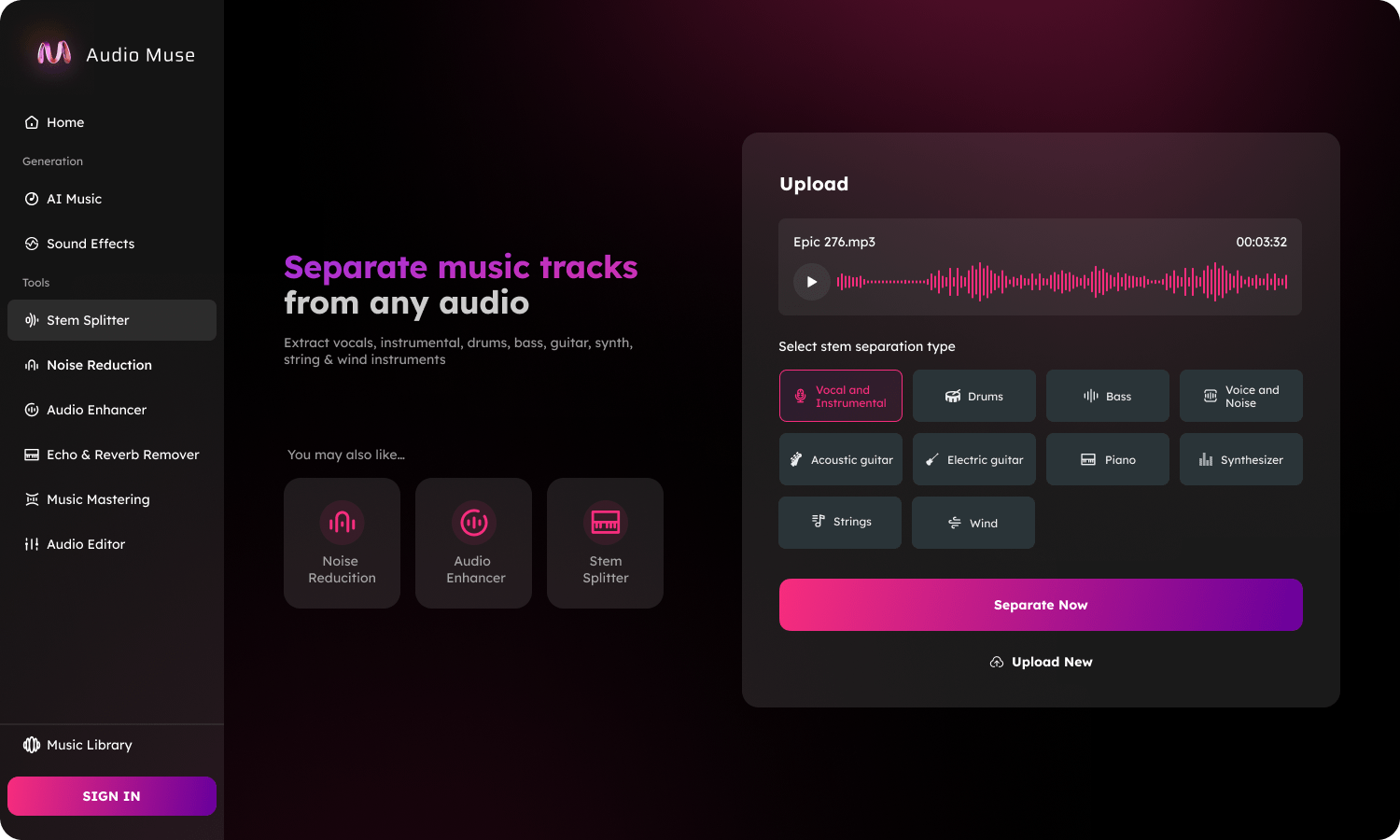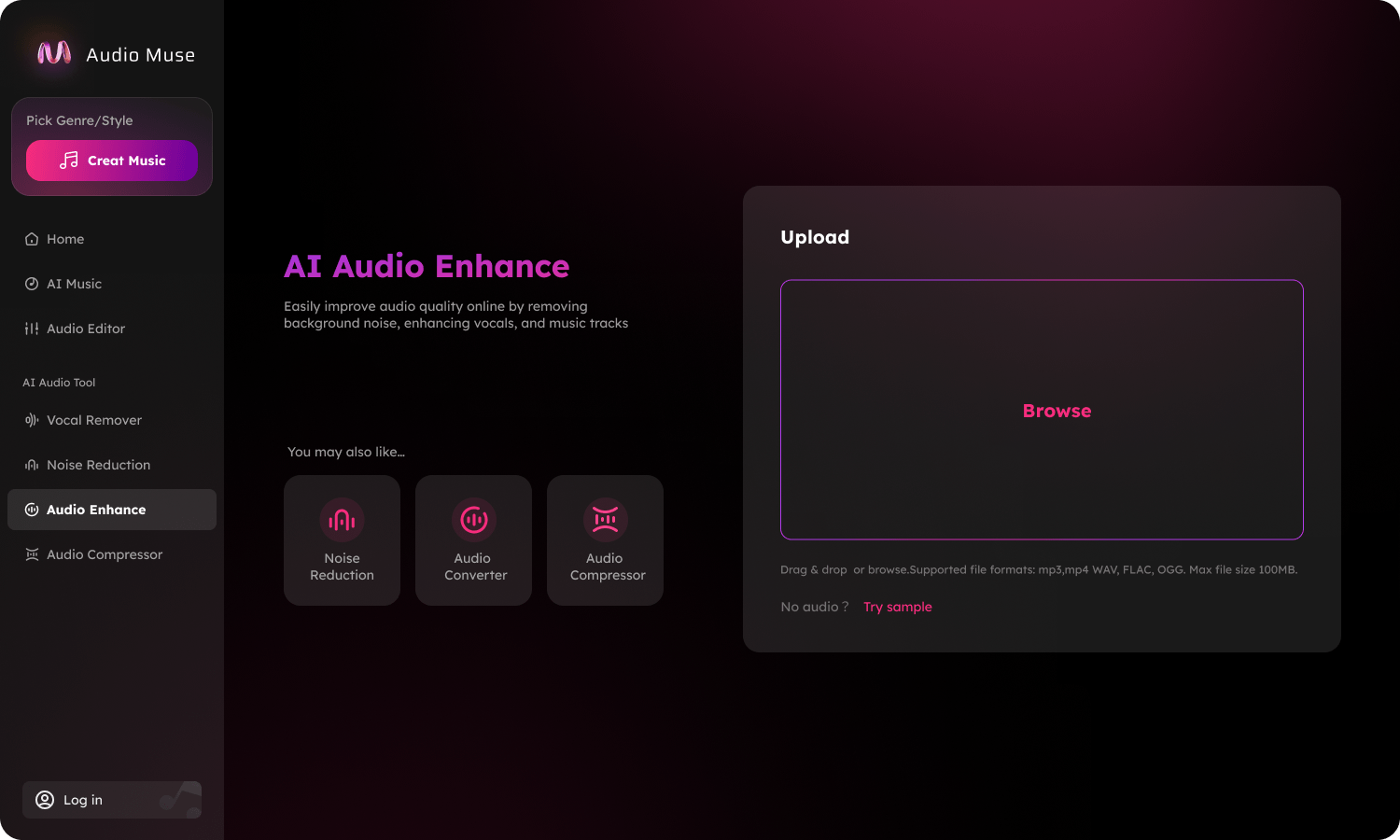Deleting or isolating specific instruments from a song has always been a challenging task for audio engineers and music enthusiasts alike. Traditionally, this process involved complex manual adjustments using digital audio workstations (DAWs) like Audacity or Adobe Audition. However, with the advent of advanced AI tools such as Audiomuse, this process has become significantly simpler and more efficient. In this comprehensive guide, we will walk you through how to delete an instrument from a song using Audiomuse's Stem Splitter tool, explore its features, and provide tips on how to enhance your audio quality post-separation.music mastering
Why Use AI Tools Like Audiomuse?
Before diving into the step-by-step guide, it's important to understand why AI tools like Audiomuse stand out in the market:
- Multi-Instrument Separation: Audiomuse doesn't just separate vocals; it can split tracks into up to 10 stems, including Acoustic Guitar, Strings, Drums, Electric Guitar, Wind Instruments, Bass, Piano, Voice & Noise, and Synthesizer.
- Key Preservation: During the extraction process, Audiomuse maintains the original pitch and tempo of your track, ensuring that no essential musical characteristics are lost.
- Mobile-Friendly: Process your tracks directly from iOS or Android browsers without needing to install any additional apps, making it incredibly convenient for musicians and producers who need quick access to their projects on-the-go.
Step-by-Step Guide Using Audiomuse
Step 1: Upload Your Track
Begin by navigating to the Audiomuse platform and selecting the "Stem Splitter" tool. Here, you can drag and drop your audio file (up to 500MB in size). Supported formats include MP3, WAV, AAC, and M4A, ensuring compatibility with a wide range of file types.
Pro Tip: For studio-quality projects, it's recommended to use lossless formats like WAV or FLAC to preserve the highest quality.
Step 2: AI Separation Process
Once your file is uploaded, the AI separation process begins. This typically takes between 10 to 30 seconds, depending on the length of the track. After processing, you can preview the isolated instruments separately, allowing for an immediate assessment of the separation quality.
Step 3: Audio Enhancement
After separating the desired instruments, you can further enhance them using various tools provided by Audiomuse. These include:
- Audio Boost: Amplifies quiet vocals without introducing distortion.
- Noise Reduction: Removes unwanted background noise, improving overall clarity.
These enhancements ensure that your final output is polished and professional.
Step 4: Export Your Project
Finally, export your project in various mainstream audio formats, providing flexibility in how you choose to use your new audio track. Whether for personal enjoyment or professional projects, Audiomuse offers a versatile solution.
Additional Tips for Effective Instrument Deletion
Choose the Right Song
Not all songs are created equal when it comes to deleting specific instruments. Songs with clear, distinct instrumentals and minimal overlap are ideal candidates. Avoid songs with heavy reverb or excessive background noise, as these can complicate the separation process.
Post-Processing
Even with advanced AI tools, some post-processing may be necessary. Use tools like EQ, compression, and reverb to fine-tune your audio track. Pay special attention to balancing volume levels and ensuring a clean sound.
Legal Considerations
Before sharing or distributing your modified track, ensure you have the proper rights or permissions. If you don't own the copyright to the original song, you'll need to obtain permission from the copyright holder. Always respect licensing agreements and fair use policies.
Conclusion
Using AI tools like Audiomuse for deleting or isolating specific instruments from a song has revolutionized the way we approach audio editing. With its user-friendly interface, advanced multi-instrument separation capabilities, and audio enhancement features, Audiomuse provides a powerful yet accessible solution for both beginners and professionals. By following the steps outlined in this guide, you can effectively remove or isolate instruments from your favorite songs, opening up new creative possibilities.
FAQ
No, most AI-based tools are designed to be user-friendly. Is it difficult to use these tools?
Most AI-based tools for audio separation are designed to be user-friendly. You typically just need to upload your audio file, select which stems (instrument tracks) you want to extract or remove, and let the software do the work for you. No advanced audio engineering knowledge is required.
What file formats are supported?
Commonly supported formats include MP3, WAV, FLAC, AAC, and M4A. It's important to check the specific requirements of the tool you're using to ensure compatibility.music mastering
How accurate is the separation process?
The accuracy varies based on the quality of the source material and the sophistication of the AI algorithm used. Some tools claim up to 98% accuracy on clear recordings with distinct instrument parts.
Can I enhance the separated tracks?
Yes, after separating the tracks, many tools offer additional features like EQ adjustments, noise reduction, and vocal enhancement to further polish the isolated elements.
Are there any limitations to consider?
While AI has made significant strides, some limitations remain. Complex mixes with overlapping frequencies or poorly recorded audio might not yield perfect results. Additionally, legal considerations should be taken into account when modifying copyrighted material.
How long does the separation process take?
Processing times can range from a few seconds to several minutes, depending on the length of the track and the complexity of the separation task.
Is there a way to preview the results before exporting?
Yes, most tools provide a preview function where you can listen to the separated tracks before finalizing the export. This allows you to assess the quality and make necessary adjustments if needed.
Can I use these tools on mobile devices?
Many AI audio separation tools are web-based and accessible through mobile browsers without requiring app downloads. However, always check if the tool supports mobile platforms directly.









